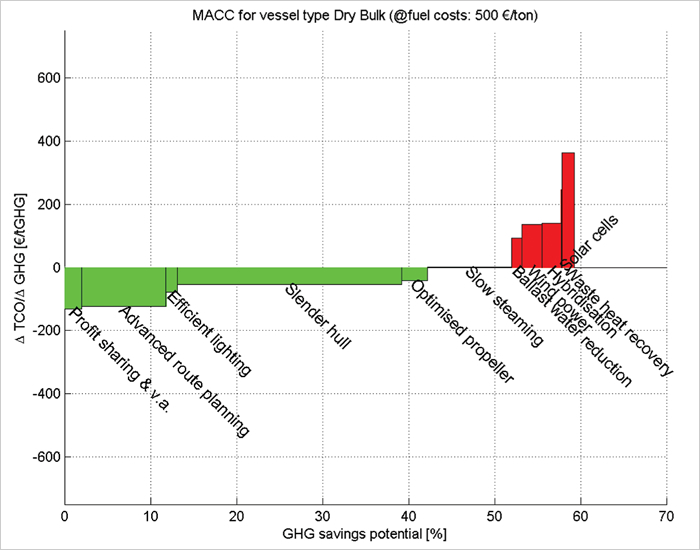Untapping the emissions reduction potential in the shipping sector could make a significant contribution to global efforts to fight climate change.
 Maritime transport emits around 1000 million tonnes of CO2 annually and is responsible for about 2.5% of global greenhouse gas emissions, which is equivalent to the annual emissions of Germany. Without mitigation measures, these emissions could grow by between 50% and 250% by 2050, according to estimates by an International Maritime Organization (IMO) study.
Maritime transport emits around 1000 million tonnes of CO2 annually and is responsible for about 2.5% of global greenhouse gas emissions, which is equivalent to the annual emissions of Germany. Without mitigation measures, these emissions could grow by between 50% and 250% by 2050, according to estimates by an International Maritime Organization (IMO) study.
Decisive action to reverse this trend will allow the shipping sector to contribute to the global low carbon transition – and reap the benefits of further energy efficiency improvements. At the same time, maritime transport is currently the only transport mode and economic sector without a greenhouse gas emissions reduction objective.
ACCELERATING THE LOW-CARBON TRANSITION
The historic Paris Agreement concluded in 2015 sets out a global action plan to put the world on track to avoid dangerous climate change by limiting global warming to well below 2°C, and to pursue efforts to limit the increase to 1.5°C.
As part of its contribution to the Paris Agreement, the EU committed to further reduce its greenhouse gas emissions, by at least 40% below 1990 levels by 2030. Sectors covered by the EU emissions trading system (ETS), such as electricity and heat production, industry and intra-EU aviation, will have to cut emissions by 43% compared to 2005. Other sectors, including road transport, will need to cut emissions by 30% compared to 2005. This commitment is currently being translated into legislation.
After the Paris Agreement, sectors outside the UN climate negotiations followed suit. Last year, the International Civil Aviation Organisation (ICAO) agreed to establish a global scheme to stabilise CO2 emissions from international aviation. This measure will require airlines to offset the growth of their CO2 emissions after 2020. In the first phase, 65 countries will participate on a voluntary basis. After 2027, participation is mandatory, except for Least Developed Countries or countries with small aviation activities.
Another major achievement last year was the agreement on the global phase-down of climate-warming hydrofluorocarbons (HFCs). These potent greenhouse gases were added to the list of substances controlled under the Montreal Protocol, the successful international treaty designed to protect the ozone layer. The phase-down of HFCs could save around 80 Gigatonnes of CO2 equivalent by 2050 and make a significant contribution to fighting climate change.
FURTHER ACTION NEEDED TO CUT SHIPPING EMISSIONS
While other sectors are making headway on tackling their emissions, the maritime transport sector does not yet have a greenhouse gas emissions reduction objective. This cannot be considered as fair. It also undermines the efforts of other sectors towards the "well below 2°C" objective of the Paris Agreement.
Some progress has already been made to address emissions from shipping. The UN body in charge of maritime transport, the International Maritime Organization (IMO), started working on the reduction of greenhouse gas emissions in 1997. In 2011, it adopted a mandatory minimum efficiency standard for new ships (Energy Efficiency Design Index, EEDI) and the obligation for ships to carry energy efficiency management plans on board.
These measures are expected to dampen further emissions growth, but not reduce emissions from today’s levels. Moreover, latest IMO figures show that many ships built in 2013 and 2014 already go beyond future requirements under the current efficiency standard. This raises concerns over the standard’s level of ambition and its ability to incentivise the uptake of existing technologies and the development of new technologies.
SHIPPING'S DECARBONISATION POTENTIAL
It is clear that further action to reduce emissions from shipping is urgently required. The good news for the sector is that it also makes good economic sense.
The second IMO greenhouse gas study, published in 2009, identified technical and operational measures that could tap into the sector’s significant emissions reduction potential. If implemented, these measures could increase efficiency and reduce emissions by 25% to 75% below the current levels.
Moreover, many of these measures are cost-effective: reduced fuel bills ensure the pay-back of operational or investment costs. Non-financial barriers, however, may discourage their implementation.
Recent studies confirm these findings. The following graph (‘marginal abatement cost curve’) visualises the emission reduction potential and the related costs for a very common ship type – dry bulkers used for example to transport iron ore or grain. Measures in green are cost-effective and those in red would trigger net costs for the ships.
On top of these measures, additional reductions could be achieved by implementing new innovative technologies.
Wind energy, for example, could be used on a number of ship types to support the conventional propulsion powered by diesel engines. A recent study commissioned by the European Commission identified a market potential for around 3,700–10,700 wind propulsion systems installed on bulkers and tankers by 2030, creating up to 18,000 new jobs.
In the long run, alternative fuels could offer further decarbonisation opportunities, as long as these fuels come from renewable energy sources.

Figure 1: Marginal abatement cost curve for dry bulkers (source: TNO: GHG emission reduction potential of EU-related maritime transport and on its impacts, study carried out for the European Commission, 2015). The graph shows that significant emission cuts can be achieved with low cost measures. Measures in green are cost-effective and those in red would trigger net costs for the ships.
AN EMISSIONS REDUCTION OBJECTIVE FOR MARITIME TRANSPORT
By tapping into this tremendous potential, the shipping sector can contribute its fair share to the global efforts to limit climate change. For a sector that is global by nature, the most effective way forward is taking action at global level through the IMO.
An important next step will be the development of the IMO’s strategy for reducing greenhouse gas emissions from ships, to be adopted in spring 2018. This initial strategy will list possible short-, mid- and long-term measures with possible timelines for completion. The idea is that it would allow the shipping sector to announce its contribution to the international effort under the stocktaking process of the Paris Agreement.
It is of utmost importance that this strategy clearly defines the sector’s level of ambition – in other words, its emission reduction objective for the mid- and longer term. This should constitute a fair share contribution to the Paris Agreement objective to limit global temperature increase to well below 2°C above pre-industrial levels.
We invite all stakeholders to actively contribute to this important work to ensure the shipping sector’s contribution to the global climate effort.